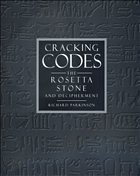Napoleon's troops discovered a granitoid slab in the village of Rosetta in the western Delta in 1799. The Rosetta Stone was to become one of the most famous Egyptian antiquities in the world as well as an instantly recognizable icon of script and decipherment. In this exciting, beautifully illustrated work, Richard Parkinson tells the story of the Stone's discovery and the so-called battle of the decipherers that it inspired. Published to accompany a major exhibition at the British Museum celebrating the bicentenary of the Stone's discovery, and including a selective catalog of the exhibits, this book also examines the wider issues of script and writing in ancient Egypt and beyond.
The Rosetta Stone is a fragment of a stela inscribed with a priestly decree in honor of Ptolemy V. The main significance of the text lies not in its content, however, but in the fact that it is written in three scripts--hieroglyphic, demotic, and ancient Greek. Early Orientalists recognized immediately the potential of the Stone for the decipherment of Egyptian hieroglyphs. Thomas Young made great advances, especially with the demotic text, but it was Jean-François Champollion who made the final breakthrough in 1822. In so doing he cracked much more than two Egyptian scripts: He opened up Egyptian culture as a whole to historians.
Among the subjects discussed in Cracking Codes are the relationship between hieroglyphs and art, the social prestige of literacy, and the power of writing and its practical aspects (scribal equipment and training). A brief description of other decipherments is also given, drawing on examples such as Linear B and Meroitic--a language which remains to be read.
A selection of the History Book Club, the Book-of-the-Month Club, and the Quality Paperback Book Club
Table of contents:
Foreword, by W. V. Davies
Preface
1. Deciphering the Rosetta Stone
2. Reading a Text: The Egyptian Scripts of the Rosetta Stone
3. Towards Reading a Cultural Code: The Uses of Writing in Ancient Egypt
4. The Future: Further Codes to Crack
Appendix: The Demotic Text of the Memphis Decree (A translation by R. S. Simpson)
Glossary
Concordance
Chronology
Index
The Rosetta Stone is a fragment of a stela inscribed with a priestly decree in honor of Ptolemy V. The main significance of the text lies not in its content, however, but in the fact that it is written in three scripts--hieroglyphic, demotic, and ancient Greek. Early Orientalists recognized immediately the potential of the Stone for the decipherment of Egyptian hieroglyphs. Thomas Young made great advances, especially with the demotic text, but it was Jean-François Champollion who made the final breakthrough in 1822. In so doing he cracked much more than two Egyptian scripts: He opened up Egyptian culture as a whole to historians.
Among the subjects discussed in Cracking Codes are the relationship between hieroglyphs and art, the social prestige of literacy, and the power of writing and its practical aspects (scribal equipment and training). A brief description of other decipherments is also given, drawing on examples such as Linear B and Meroitic--a language which remains to be read.
A selection of the History Book Club, the Book-of-the-Month Club, and the Quality Paperback Book Club
Table of contents:
Foreword, by W. V. Davies
Preface
1. Deciphering the Rosetta Stone
2. Reading a Text: The Egyptian Scripts of the Rosetta Stone
3. Towards Reading a Cultural Code: The Uses of Writing in Ancient Egypt
4. The Future: Further Codes to Crack
Appendix: The Demotic Text of the Memphis Decree (A translation by R. S. Simpson)
Glossary
Concordance
Chronology
Index

